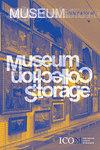印度博物馆收藏:十年回顾
IF 0.4
4区 艺术学
0 ART
引用次数: 1
摘要
摘要印度博物馆的诞生源于殖民统治。尽管该国目前拥有800多家博物馆,但妥善的藏品管理及其作为博物馆关键职能的处理并没有得到广泛的重视。仍然存在一些挑战,包括缺乏空间、资金稀缺和分配不当,以及至关重要的是,缺乏藏品储存和管理的国家标准和指导方针。尽管印度政府在2014年通过一项名为JATAN的倡议创建了一个数字存储库,但该行业在藏品存储和文档以及藏品数字化方面仍然落后。这篇文章借鉴了匿名受访者对一份专门设计的问卷的回答,考察了印度不充分的收藏做法,同时也评估了过去十年印度博物馆专业人员对藏品收藏的态度。此外,它还揭示了管理藏品的人和在次大陆策划藏品的人之间的巨大分歧。这篇文章还为制定藏品储存和使用的国家政策提供了一个模板:该政策涵盖了多个问题,从天气条件和灾害到与神圣相关的物品(尤其是在体现活遗产的宫殿中)。总之,这些建议有助于印度各博物馆的做法标准化。这篇文章还强调了印度和世界各地对研究、教学和策展等多种用途的文献指南和藏品可访问性的要求。最后,它探讨了鉴于教育框架不足和缺乏正式教授的博物馆学课程,加强能力建设的必要性。为此,它讨论了十多年来发表的重要国家和国际报告,以及通过与专业人士的初步互动收集的定性数据。本文章由计算机程序翻译,如有差异,请以英文原文为准。
Museum Collection Storage in India: A Decade in Review
Abstract The birth of museums in India has its origins in colonial rule. While the country today counts over 800 museums, proper collections management and its treatment as a pivotal museum function have not taken hold widely. Several challenges remain, including a lack of space, the scarcity and misallocation of funds, and, critically, an absence of national standards and guidelines for collections storage and management. While the Indian government created a digital repository in 2014 through an initiative called JATAN, the sector still trails behind in the fundamentals of collection storage and documentation, and in digitising collections. This article, drawing on responses from anonymous respondents to a specially designed questionnaire, examines inadequate storage practices in India, while also assessing the attitudes of Indian museum professionals towards collection storage over the last decade. Further, it sheds important light on the sharp divide between those who manage collections and those who curate in the subcontinent. The article additionally offers a template for the development of a national policy for collection storage and usage: one that covers multiple concerns, from weather conditions and disasters to objects of sacred relevance (especially in palaces that exemplify living heritage). Taken together, these suggestions can serve to standardise practices across museums in India. This article also highlights a requirement for documentation guidelines and accessibility of collections for myriad uses—research, teaching and curation—across India and the world. Lastly, it explores the need for greater capacity building, given insufficient educational frameworks and a lack of formally taught museology courses. For this purpose, it discusses crucial national and international reports published over a decade and qualitative data gathered through primary interactions with professionals.
求助全文
通过发布文献求助,成功后即可免费获取论文全文。
去求助
来源期刊

MUSEUM INTERNATIONAL
ART-
CiteScore
0.60
自引率
0.00%
发文量
0
期刊介绍:
In its new revised form Museum International is a forum for intellectually rigorous discussion of the ethics and practices of museums and heritage organizations. The journal aims to foster dialogue between research in the social sciences and political decision-making in a changing cultural environment. International in scope and cross-disciplinary in approach Museum International brings social-scientific information and methodology to debates around museums and heritage, and offers recommendations on national and international cultural policies.
 求助内容:
求助内容: 应助结果提醒方式:
应助结果提醒方式:


